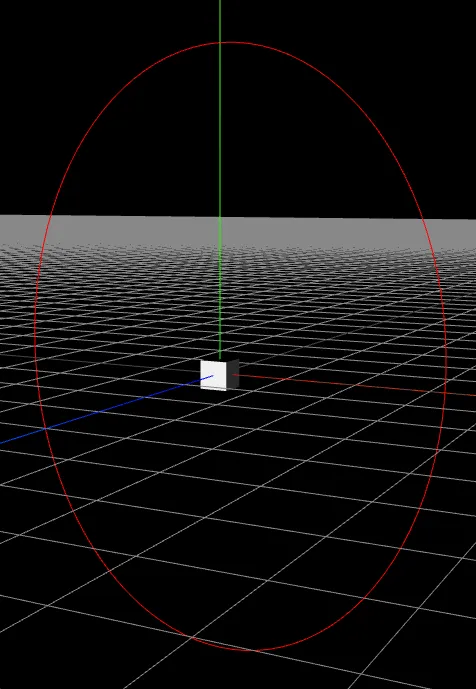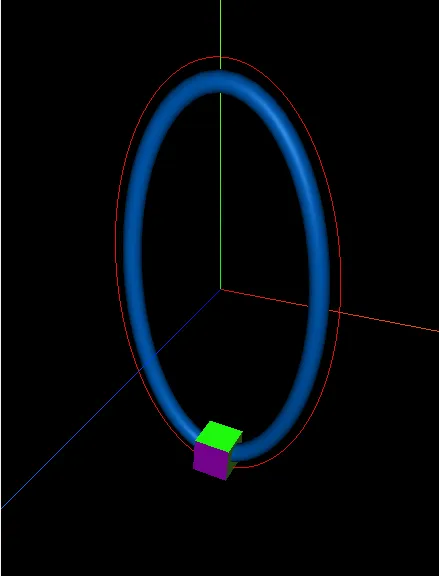var cubes = [], marker, spline;
var matrix = new THREE.Matrix4();
var up = new THREE.Vector3( 0, 1, 0 );
var axis = new THREE.Vector3( );
var pt, radians, axis, tangent, path;
var t = 0;
function getCube(){
var mats = [];
for (var i = 0; i < 6; i ++) {
mats.push(new
THREE.MeshBasicMaterial({color:Math.random()*0xffffff}));
}
var cube = new THREE.Mesh(
new THREE.CubeGeometry(2, 2, 2),
new THREE.MeshFaceMaterial( mats )
);
return cube
}
function Ellipse( xRadius, yRadius ) {
THREE.Curve.call( this );
this.xRadius = xRadius;
this.yRadius = yRadius;
}
Ellipse.prototype = Object.create( THREE.Curve.prototype );
Ellipse.prototype.constructor = Ellipse;
Ellipse.prototype.getPoint = function ( t ) {
var radians = 2 * Math.PI * t;
return new THREE.Vector3( this.xRadius * Math.cos( radians ),
this.yRadius * Math.sin( radians ),
0 );
};
var mesh, renderer, scene, camera, controls;
function init() {
renderer = new THREE.WebGLRenderer();
renderer.setSize( window.innerWidth, window.innerHeight );
document.body.appendChild( renderer.domElement );
scene = new THREE.Scene();
camera = new THREE.PerspectiveCamera( 45, window.innerWidth / window.innerHeight, 1, 1000 );
camera.position.set( 20, 20, 20 );
controls = new THREE.OrbitControls( camera, renderer.domElement );
controls.addEventListener( 'change', render );
controls.minDistance = 10;
controls.maxDistance = 50;
var light = new THREE.PointLight( 0xffffff, 0.7 );
camera.add( light );
scene.add( camera );
scene.add( new THREE.AxisHelper( 20 ) );
marker = getCube();
marker.position.set(0,0,0);
scene.add(marker);
path = new Ellipse( 5, 10 );
var pathSegments = 64;
var tubeRadius = 0.5;
var radiusSegments = 16;
var closed = true;
var geometry = new THREE.TubeBufferGeometry( path, pathSegments, tubeRadius, radiusSegments, closed );
var material = new THREE.MeshPhongMaterial( {
color: 0x0080ff,
} );
mesh = new THREE.Mesh( geometry, material );
scene.add( mesh );
var curve = new THREE.EllipseCurve(
0, 0,
6, 11,
0, 2 * Math.PI,
false,
0
);
var path2 = new THREE.Path( curve.getPoints( 100 ) );
geometrycirc = path2.createPointsGeometry( 100 );
var materialcirc = new THREE.LineBasicMaterial( {
color : 0xff0000
} );
var ellipse = new THREE.Line( geometrycirc, materialcirc );
ellipse.position.set(0,0,0);
scene.add( ellipse );
}
function animate() {
requestAnimationFrame(animate);
render();
}
function render() {
pt = path.getPoint( t );
marker.position.set( pt.x, pt.y, pt.z );
tangent = path.getTangent( t ).normalize();
axis.crossVectors( up, tangent ).normalize();
radians = Math.acos( up.dot( tangent ) );
marker.quaternion.setFromAxisAngle( axis, radians );
t = (t >= 1) ? 0 : t += 0.002;
renderer.render( scene, camera );
}
init();
animate();
<script src="https://cdnjs.cloudflare.com/ajax/libs/three.js/82/three.min.js"></script>
<script src="https://threejs.org/examples/js/controls/OrbitControls.js"></script>

